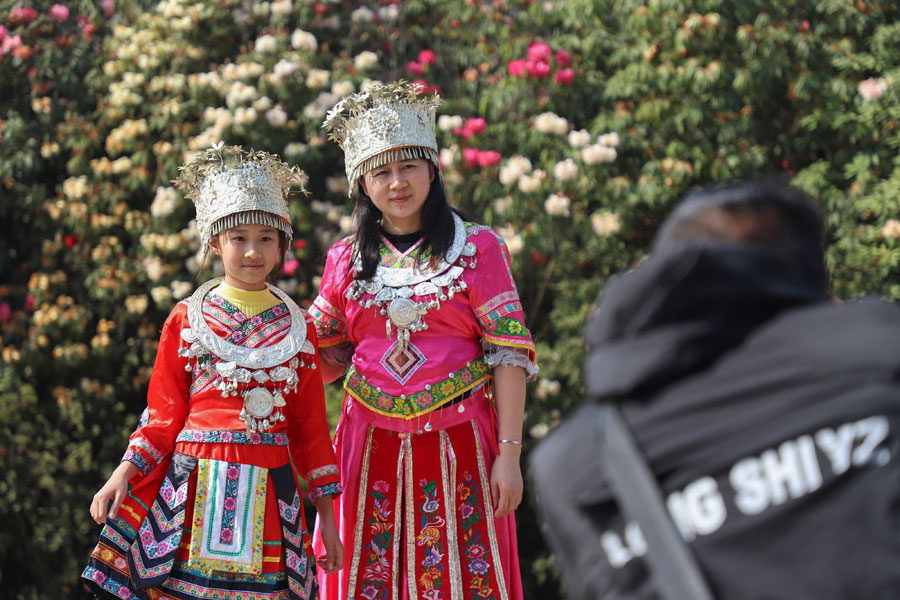Rural tourism helps Bijie bloom
Tourists from home and abroad made 798,000 visits last year to the Baili Azalea Administrative Zone, an experimental zone in a core poverty alleviation area, generating revenue of 585 million yuan (US$84.3 million).
Named for its sea of azalea flowers, the Baili Azalea Administrative Zone, comprising 68 villages across some 700 square kilometers of hilly land in Bijie, Guizhou province, is an experimental zone in a core poverty alleviation area.

The zone has struck a balance between ecological preservation and economic growth by boosting sightseeing and cultural experience tourism.
Rural tourism has created 46,000 jobs for residents, most of whom would otherwise work far from home as migrant laborers, according to the local government.
Last year, tourists from home and abroad made 798,000 visits to the zone —which has 16 characteristic villages, more than 20 scenic spots, 391 restaurants and homestays and 6,700 beds for travelers-generating revenue of 585 million yuan (US$84.3 million) and helping increase average household income by 10,600 yuan a year.
The zone's administrative committee is working with travel companies and farming cooperatives to manage tourism resources.
The committee focuses on improving infrastructure facilities and public services, while the companies and cooperatives run and promote scenic spots.
All stakeholders have attached great importance to raising environmental awareness and encouraging residents to protect the local ecology.
Companies and cooperatives evaluate and rate the zone's restaurants and homestays in terms of their facilities, management and services, pushing businesses to rectify any problems.
Farmers have also planted about 3,000 hectares of flowers, fruits, mushrooms, herbs and other plants that are more profitable than corn, which locals have grown for generations, and have created packages for tourists to experience the planting and harvest seasons firsthand.
The city government has resettled poor residents from remote, high-altitude areas to the foot of the mountains, where transportation is more convenient.
"The living environment is much better. I didn't expect that my family could move into a new three-story house, equipped with running water and electricity, without paying a thing," said Zhao Anyou, one of 116 people relocated from Yuanyan village to government-subsidized homes in the town of Pudi.
Cooperatives organize at least five training sessions a year for farmers like Zhao, to equip them with the skills they need for their new lifestyles, and are constantly improving management and services.
Xiao Tianyao, 92, from Luzhou, Sichuan province, stayed with her daughter in the Baili zone from more than a month over the summer. She told Bijie Daily, "I didn't anticipate finding a perfect combination of cool weather, fresh air, beautiful scenery, modern facilities, considerate services and hospitable people in such a remote, inland, mountainous area as Bijie."
She added that she hopes to return to the area every summer.
During a recent inspection of the zone, Zhou Jiankun, Bijie's Party secretary, called on local officials to further improve public services, particularly in healthcare, education, infrastructure and hygiene.
Experts said the seamless convergence of management experience, capital, land and labor resources are the key factor that has helped increase farmers' incomes and raised agricultural output efficiency.
Companies and cooperatives are making joint efforts to extend the industrial chain of rural tourism by building workshops to process and produce agricultural products and tourist commodities, such as silk azaleas, traditional outfits and specialty foods.
Authorities have paid special attention to protecting and industrializing local culture. Fuyuan village, for example, was one of the first to be distinguished for its ethnic characteristics, while the Yi ethnic group's floral sacrifice ceremony has been recognized as Bijie's intangible cultural heritage, and traditional torch festival has become a major tourist draw.
Thanks to effects of rural tourism on poverty relief, the Baili zone was named one of China's 280 tourism poverty alleviation demonstration projects.
The zone is only one example of Bijie's poverty alleviation endeavors. Since 1988, when the State Council earmarked the city as a national poverty alleviation experimental area, Bijie's impoverished population has shrunk by 5.94 million (about 700,000 people still live below the poverty line), and the poverty rate has dropped from 65.1 percent to 8.89 percent.
In Bijie, the average personal disposable income in rural areas has risen from 182 yuan per year in 1987 to 8,473 yuan per year in 2017. Meanwhile, GDP has increased by 103 times.

